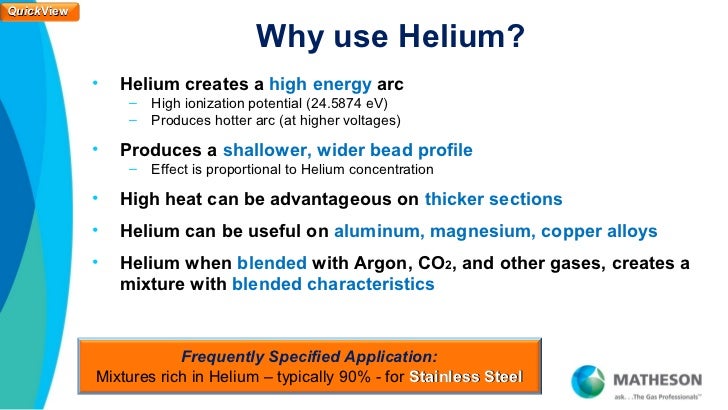Helium is one of the most common elements in the universe. It is called a noble gas because it doesn’t chemically interact with elements. Its atomic number is 2 and the weight is 4.002. In its natural state, it doesn’t have any smell, taste or color.
Common Uses of Helium
After hydrogen, helium is the second most abundant element in the universe. It is present in all stars. It was, and is still being, formed from alpha-particle decay of radioactive elements in the Earth. Some of the helium formed escapes into the atmosphere, which contains about 5 parts per million by volume.
- About a third of it is used in cryogenics - keeping things very cold. Things like MRI machines use a lot of helium. The Large Hadron Collider uses close to 100 tons of the stuff for cooling! It’s also used in some welding applications, for leak de.
- After the crash of the hydrogen-filled R101, in which most of the crew died in the subsequent fire rather than the impact itself, Hindenburg designer Hugo Eckener sought to use helium, a non.
- Helium was the first element that was not discovered on Earth. It was Sun’s spectroscopy data that.
Evidence shows that the human voice can be changed with a bit of helium. The gas is also used as light weight aircraft fuel. The element is usually combined with hydrogen in air balloons. Hydrogen alone is fine, but helium makes the balloon safer to use. The same gas is used by caisson workers too. Divers use oxygen and helium during their dives. The combination provides them with the atmosphere necessary to survive in high pressure environments.
Medical Applications
Helium can also be used for breathing observation. It is essential in treating ailments asthma, emphysema and other conditions that affect breathing. The gas is usually used to treat diseases that affect the lungs. Hospital MRI scans relies on liquefied helium. When the element is set at -269 C (the low boiling point), it becomes usable in MRI magnet cooling down.
Acute and chronic forms of respiratory ailment treatments have helium components. In almost all cases, oxygen and helium are used together. This combination gets to the lungs much quicker. Helium in different forms and combinations are used in medical instrumentations and nuclear medicine.
Welding and Magnet Production
Helium is used to cool down superconduction magnets. This is required during their operation. Welding companies also rely on it to provide protection. It is used the same way in the development of titanium, zirconium, germanium and silicon.
Other Applications
Hydrogen and oxygen are often used as rocket fuel. Helium-neon lasers use the element extensively. These instruments are used for barcode reading. The same element is needed to monitor small fractures in ships and other vehicles.
Helium dating is relied on to date rocks that contain uranium and titanium. The gas is used for protection during germanium crystal and silicon production. It is valued as a protective gas because of its inert nature.

Helium’s properties also make it ideal for observation in quantum mechanics. Its structure is basic and easy to study. Numerous mathematical processes are used to assess subatomic particle behavior. Using these techniques, neutrons, electrons and protons can be studied. However, these tests cannot determine their actions 100% accurately. This is due to the nature of quantum mechanics.
Important Use Of Helium
Uses of Helium in Space Technology
NASA space programs use the gas to fuel their shuttles. Liquid fuels are volatile. They are packed with corrosive material that could destroy a spacecraft’s casing. To avoid this problem, a craft is filled with helium gas. The same process is used in blimps and air balloons. It is preferred to hydrogen for two reasons. It is lighter and not flammable. The element is also used to keep nuclear reactors cool.
Occurrence and Discovery
Helium can be found all over the universe, although it isn’t widely distributed on Earth. Its most frequent form is gas. It shares many characteristics with other noble gases. Helium doesn’t form compounds easily with other elements. It is also very stable. But as the facts earlier show, the element is very usable. Its symbol in the periodic table is He. Its stability and non-reactive nature makes it the perfect tool for handling unstable materials. The element was discovered in 1868 during a solar eclipse. It took scientists 30 years to extract and isolate the gas from the clevite mineral.
The gas is not prevalent on Earth. It is usually extracted from natural gas. The typical amount found ranges from 2 to 7%. It didn’t take long for governments to realize its usefulness in military operations. Access to it was restricted during the two World Wars. In its purest form, the element doesn’t pose any health risks.
However, inhaling excessive amounts has its risks. The danger is the gas functions as an asphyxiate. Inhaling helium from pressure tanks can damage the lungs. The variants found in weather balloons may have other elements that are unhealthy to breathe.
Properties
Its atomic number indicates there are two electrons and two protons in a neutral helium atom. Its most vital properties are density, melting and boiling points, state of matter and atomic mass. The density is 101.325 kilopascals (kPa) and 0.1786 grams per liter at 32°F (0.0°C). Its atomic mass is 4.0026 grams per mole.
Solid and liquid helium can only manifest in high and low temperature settings. Either condition cannot manifest under normal pressures. -458 F (0.95 Kelvin) is the melting point. The boiling point is -452°F (4.22 Kelvin).
Use Of Helium Gas In Hindi
One of the more interesting uses of helium is in cryogenics. This field is concerned with low temperature phenomena and its production. Most of the helium produced today is used for cryogenics.
Like most blockchains, Helium has a system of transaction fees. All transactionsin the Helium blockchain are paid in Data Credits (DCs). Data Credits areproduced via burning some amount of HNT using an on-chain transaction. Andthanks to a system called 'Implicit Burn', users (typically) don't need tomanually supply DCs to pay fees. As long as the Helium wallet being used tosubmit the transaction contains enough HNT to burn to DCs to fund thetransaction, the burn will happen implicitly, requiring no user intervention.
Transaction Fee Schedule
The following is a list of the current set of fees required for varioustransactions, along with their details. Transaction fees are paid in DataCredits. (Note that the cost is not shown in HNT as this number is variablebased on the current $USD/HNT price as defined by the HNT Price Oracle.)
| Fee Type | Fee Description | Cost (DC) | Cost ($USD) |
|---|---|---|---|
| Send HNT | Transferring HNT from wallet to wallet | Variable | Variable |
| Transferring Device Packet Data | Fee paid by device owner when sending or receiving sensor data. Metered per 24 bytes. | 1 | $.00001 |
| Add Miner | Fee paid to add Miner to the blockchain. (Only applies to non-Helium Hotspots.) | 4000000 | $40 |
| Assert Miner Location | Required when asserting a Gateway's location. (The first two assertions for Helium Hotspots are paid by Helium, Inc. ) | 1000000 | $10 |
| Purchasing a blockchain OUI | Buy an OUI from the Helium blockchain | 10000000 | $100 |
| Purchasing a blockchain Subnet | Buy a Subnet from the Helium blockchain | 10000000 | $100 |
Calculating the DC cost for Sending HNT
As noted above, the DC cost of a Send transaction is variable. The precisecost is based on the size of the transaction, in bytes. Once the size iscalculated, we apply a 5000x multiplier. For a typical send transaction, whereone wallet is sending to one wallet(like this one here),the complete transaction is made up of the following:


| Transaction Component | Component Size (Bytes) |
|---|---|
| Payer Wallet Key | 33 |
| Payee Wallet Key | 33 |
| Payer Signature | 64 |
| Nonce | 3 (approximate; ranges from 2-4) |
| Payment Amount | 6 (approximate; ranges from 4-8) |
- In total, this is
139bytes. - Each
24bytes requires one Data Credit (as is the case when you'retransferring device packet data). 139/24results in6Data Credits.- We then apply our 5000x multiplier, and the result is a transaction fee
- This results in a
30000 Data Creditcost for the above transaction.
Transaction Fees and Implicit Burn
The Helium blockchain uses something called implicit burn when paying fees.
Implicit Burn™
The term implicit burn was coined by Helium PM Coco 'cokes' Tang, a recognizedinnovator in the blockchain technology and terminology space.
Thanks to Implicit Burn™, if you have enough HNT in your wallet to pay thetransaction fee, the Helium Mobile Wallet (or the Helium Wallet CLI) willcalculate the DC cost of your transaction and the blockchain will automaticallyburn the precise amount of HNT to supply the required DCs for the transaction.For example:
5 Common Uses Of Helium
- You need to send
10 HNTfrom a Helium Wallet that contains11 HNT - The cost for this
sendtransaction is35000 DCs - Let's assume the
HNT/$USDOracle Price is$.35at the time you send theHNT. This means that you'll need to supply a1HNTto fund the35000 DCsfor this transaction. - When you send the
10 HNT, the Helium Wallet automatically supplies the1 HNTto be burned intoDCs. - After the transaction is submitted and processed, your resulting Helium Walletbalance will be
0 HNT.
In the above example, had you attempted to send 10.0001HNT with only. 11 HNTin your wallet, this transaction would have failed as burning .999 HNT wouldonly result in 34965 DCs, a mere 35 DCs short of the 35000 required for asend transaction.
Failed Transactions Result in No DCs Being Spent
Transactions in the Helium blockchain are atomic. In short, this means thatthey either succeed entirely or they don't. So, if you attempt to send HNT froma Helium Wallet without enough HNT to supply the required Data Credits, thetransaction will fail after being submitted to the blockchain API by yourwallet. And your HNT balance will be the same. No DCs were burned (orharmed) in this failed transaction.
